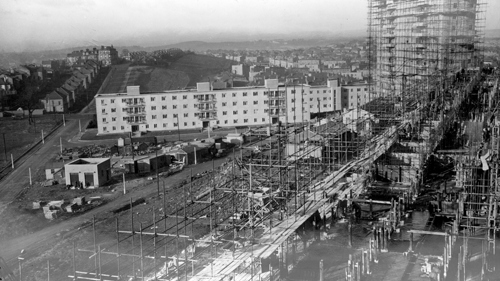Multi-storey flats - Times Past

In partnership with the Glasgow Times, our archivists are exploring Glasgow's fascinating history. This week, Irene O'Brien writes about multi-storey flats.
In the 1950s, Glasgow Corporation earmarked twenty-nine areas across the city as Comprehensive Development Areas. As the City ran out of building land to house the displaced families within the city, the Corporation decided the only way was up. Forced into action by the continuing housing crisis, Glasgow constructed over 230 blocks between 1955 and 1975. This was more high-rise flats than any other city in Europe, including the communist bloc
Crathie Court, Partick (1950-1952) and Moss Heights, Cardonald (1950-1954) were the two prototype high rise projects which had been developed by the Director of Housing from 1943-1947.
Crathie Court was completed by the Housing Department in 1952. Eight storeys high, it contained eighty-eight bedsits for unmarried women, earning the nickname “spinster flats.” Its construction set the scene for future high-rise council housing in Glasgow.
Although only ten storeys high, Moss Heights was built on high ground which added to their dramatic appearance. Once tenants had moved in, it was discovered that the lifts installed in the buildings were too small to carry coffins and large items of furniture. The problem was a foretaste of others to come when higher blocks were erected in the city.
With the pressure to rehouse quickly and relatively densely, new high blocks started rising around the city. These blocks were usually built quickly and cheaply, often through "package deals" with commercial contractors.
Gorbals had been the first part of Glasgow to be promoted for comprehensive redevelopment under post-war planning legislation. Redevelopment plans for Hutchesontown received Government approval in 1957 and eminent architects were involved in the design of the high-rise housing. Shortly afterwards Laurieston was also redeveloped for housing which included the enormous tower blocks which dominated Gorbals Cross. Much of the replacement housing was poorly designed or was impossible to maintain at economic cost - particularly infamous were the damp-ridden Hutchesontown "Area E" and Sir Basil Spence's 20-storey slab apartment blocks at Queen Elizabeth Square, demolished in 1987 and 1993, respectively.
The build them high trend reached its peak with the construction of two 28-storey “slab” blocks and six 31-storey “point” blocks at Red Road, which were designed for Glasgow Corporation in 1962 by Sam Bunton & Associates. At the time, they were the tallest residential blocks in Europe.
As with other high-rise schemes, poor planning and cost-cutting resulted in a lack of amenities, poor services and a high incidence of vandalism and other social problems. In 1980 two blocks of flats were declared unfit to live. One was converted for student and executive use and another for the YMCA. In recent years some of the Red Road flats housed Kosovan refugees and were later home to asylum seekers from the Horn of Africa, Asia, the former Soviet Union, Iran, and Iraq.
All the Red Road flats were demolished in 2015. Of the 230 high-rise blocks of Council houses, only about sixty-seven remain.
